 Correlations & Graphs
Correlations & GraphsIn this portion of my research, I investigated the significance of federal aid, schooling, and household status on the HIV and AIDS rates in Brooklyn. Demographics had a significant affect on the number of new HIV cases, and cumulative AIDS cases in the borough. The N-value for my data is 35 and in order for a correlation to be significant at p-value<0.05, it has to be greater than 0.334. Areas with a lower socio-economic status are more likely to have higher rates of HIV infection. About two thirds of the data that was collected to produce correlations showed that the rate of transmission of HIV increased in Brooklyn from 2001 to 2004 when compared to the rate cumulative AIDS cases from previous years.
Social security was the first of the categories that I viewed with an HIV rate correlation of -.65. Since the correlation was negative, it showed that as the percentage of people, generally the elderly, who received social security increased, the rate of HIV diagnoses decreased significantly. Not only can one see that the rate among the elderly is low, but one can infer that elderly members of the population are less sexually active than younger people. This might be the factor that limits the spread of HIV in their age group. Also, the cumulative AIDS correlation which was -.67 enabled me to conclude that there has not been much of a change in the affects on the elderly population throughout the years that HIV/AIDS has been ravaging Brooklyn’s total population. This also means that HIV/AIDS has the greatest impact on age groups below the age of sixty-five.
|
Social Security |
Correlation Coefficient |
P-value |
Significant (0.334) |
|
HIV |
-.64 |
0.05 |
Yes |
|
AIDS |
-.65 |
0.05 |
Yes |


Age groups below the sixty-five received aid similar to social security called public assistance or welfare. The correlation for public assistance was positive at .66 which meant that as the percentage of people who received public assistance increased, the HIV rate increased. This obviously means that a lower socio-economic status has an fairly significant effect on the HIV rate within a community. Some people who are provided with welfare are also provided with public housing. After years of living in Brooklyn, I know that many neighborhoods such as Crown Heights, Bedford Stuyvesant, East New York, Williamsburg and Bushwick (11212, 11216, 11233, 11238, 11201, 11226 and 11221) have large public housing facilities that have moderate to high rates of intravenous drug use. Therefore, it is not coincidental that the correlation shows higher rates of HIV infection in these neighborhoods than in many other neighborhoods in Brooklyn.
|
Public Assistance |
Correlation Coefficient |
P-value |
Significant (0.334) |
|
HIV |
.66 |
0.05 |
Yes |
|
AIDS |
.54 |
0.05 |
Yes |
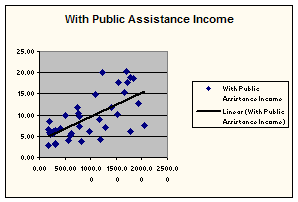

In contrast to people who received public assistance, the correlation for those who did not receive public assistance in the year 1999 was -.66. This means that as the percentage of people living without public assistance increased, the rate of people with HIV decreased significantly. One factor that could have influenced this is that people with careers have less idle time than people without careers. The assumption being made here is not that all people who are provided with public assistance do not have jobs, because some might have jobs that just do not have salaries high enough to provide for decent living; however, this correlation shows that people with well-paying jobs are less likely to engage in behavior that would put them at risk for contracting HIV. This could be a result of the fact that they are not as stressed as people with jobs that pay less; they do not have to worry about living a comfortable life. Bay Ridge, Sheepshead Bay, Greenpoint, and Canarsie (11209, 11214, 11228, 11223, 11224, 11229, 11235, 11211, 11222, 11234, 11236 and 11239) are just some of the neighborhoods that have a lower number of people who receive public assistance. Some of these neighborhoods also happen to be predominantly white. This directly relates to the fact that there are fewer HIV cases among the white population of Brooklyn. Although the overall correlation for HIV positive people without public assistance is negative, when compared to the correlation of cumulative AIDS cases there has still been an increase in the number of infections.
|
No Public Assistance |
Correlation Coefficient |
P-value |
Significant (0.334) |
|
HIV |
-.66 |
0.05 |
Yes |
|
AIDS |
-.54 |
0.05 |
Yes |
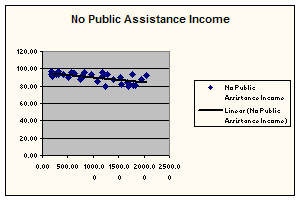
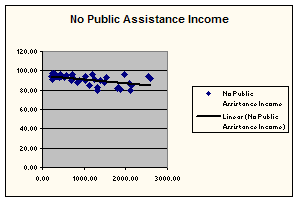
Socio-economic status is not the only aspect of life that contributes to the number of HIV/AIDS cases in Brooklyn. Education also plays a major role on awareness about the illness. The correlation of black students in grade 9 to 12 was .36; this means that as the percentage of students increased, there was a slight increase in the rate of HIV diagnoses. This data shows that schools in predominantly black neighborhoods are probably not providing adequate sex education programs, and the discussion in classes about the modes of transmission of HIV and methods for prevention are limited. Another factor may be that students do not fully appreciate the importance of the classes because the classes seem superficial. As discussed in the first paper, many classes teach abstinence, and do not explain other possible methods of prevention. This also verifies that race is a significant issue when the rate of transmission is taken into consideration because there are calculations to support the research.
|
Grades 9-12 (Blk) |
Correlation Coefficient |
P-value |
Significant (0.334) |
|
HIV |
.36 |
0.05 |
Yes |
|
AIDS |
.37 |
0.05 |
Yes |
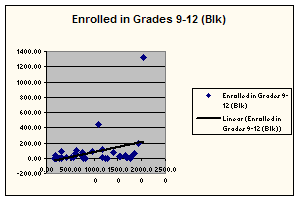
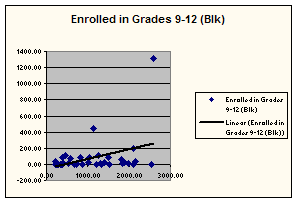
The number of black students enrolled in college like the high school students showed a positive HIV rate correlation of .35. This means that as the percentage of students increased, the number of HIV cases increased slightly. Surprisingly, the correlation of HIV infection among college students is lower than that of students in high school; however, they are still increasing. The rates of infection according to zip code are also similar to those of students in high school. Clearly, the majority of young people are unaware of the prevalence of HIV/AIDS in their neighborhoods, and that they are also unaware that they are at risk. The HIV rate correlation along with the AID cumulative correlation which is show that there are quite a few more cases now than there were previously when the two are compared to the number of cumulative AIDS cases which was .37.
|
College (Blk) |
Correlation Coefficient |
P-value |
Significant (0.334) |
|
HIV |
.35 |
0.05 |
Yes |
|
AIDS |
.38 |
0.05 |
Yes |
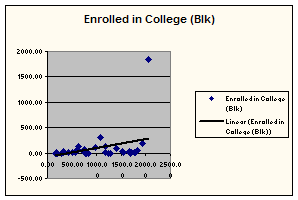
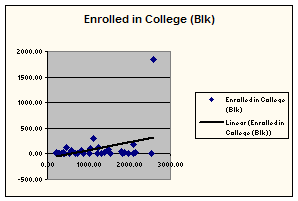
While the correlations for people in schools were significant, the correlation for the number of people not enrolled in school was higher, and this was expected. The correlation was .35, which meant that as the percentage of people increased, the number of people infected with HIV increased. The most understandable assumption would be that people with idle time are more at risk for experimenting with drugs, particularly those that require injection. As previously mentioned, East New York (11207 and 11208) has a higher IDU percentage than many other neighborhoods, so it is not surprising that its data shows the highest percentage of people not enrolled in school. Bedford Stuyvesant and Crown Heights have the second highest number of people not enrolled in schools, and like East New York, both neighborhoods have high rates of IDU. When the correlation of the number of people living with HIV is compared to the correlation of cumulative AIDS cases among people who are not in school, an increase in transmission is once again apparent.
|
Not Enrolled |
Correlation Coefficient |
P-value |
Significant (0.334) |
|
HIV |
.35 |
0.05 |
Yes |
|
AIDS |
.38 |
0.05 |
Yes |
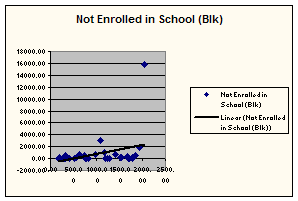
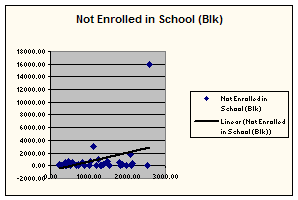
Although the increase of the rate of transmission has occurred generally, it is having a particularly devastating affect upon women in Brooklyn. The correlation for the amount of households with a female householder was .44. Sadly, it was not unexpected to find that the number of HIV cases increased as the percentage of women increased. As shown by data previously collected, the rate of heterosexual transmission has taken a toll on women in Brooklyn. Bushwick and Williamsburg, which are predominantly Hispanic neighborhoods, have some of the highest numbers of female householders in the borough, and these neighborhoods also happen to have some of the highest rates of HIV cases. One can also gather that other people within the household are at a greater risk. Children and teenagers for example are not under regular supervision because the mothers need to work in order to provide for the household. The absence of the only parent increases the risk of children and teenagers being involved in sexual activity, and it contributes to the high HIV rates.
|
Female Householder |
Correlation Coefficient |
P-value |
Significant (0.334) |
|
HIV |
.44 |
0.05 |
Yes |
|
AIDS |
.29 |
0.05 |
No |
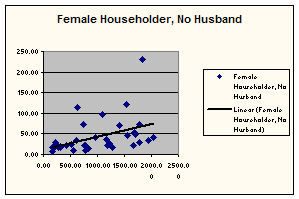
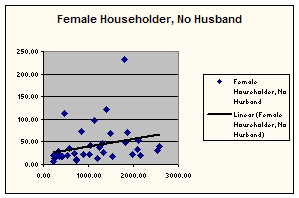
After examining the data for female households, households in general was the next factor to consider. They were distinguished by owner occupied housing, and renter occupied housing. Owner occupied housing showed a negative correlation of -.54, which indicated a higher socio-economic standing because as the percentage of owner occupied housing increased, the number of HIV cases decreased. One aspect of the information that was surprising was that although the correlation was low, some wealthy areas showed a higher rate of HIV diagnoses. These areas were Park Slope, Brooklyn Heights and Downtown Brooklyn (HIV rates: 11201 is 1185.44, 11205 is 1668.44, 11217 is 1773.54 and 11231 is 1279.80); however, although these areas are well-to-do, they most likely have a higher amount of homosexual white males. In contrast to owner occupied housing, there was a positive correlation of .54 for renter occupied housing, which means that as the percentage of renter occupied housing increased, the number of HIV cases increased. This is most likely due to a lower socio-economic standing because many people cannot afford to own their own houses. Also when both of these types of housing were compared, they both showed that the rate of HIV cases has increased when compared to the cumulative AIDS cases.
|
Owner Occ. Housing |
Correlation Coefficient |
P-value |
Significant (0.334) |
|
HIV |
-.54 |
0.05 |
Yes |
|
AIDS |
-.50 |
0.05 |
Yes |


|
Renter Occ. Housing |
Correlation Coefficient |
P-value |
Significant (0.334) |
|
HIV |
.54 |
0.05 |
Yes |
|
AIDS |
.50 |
0.05 |
Yes |
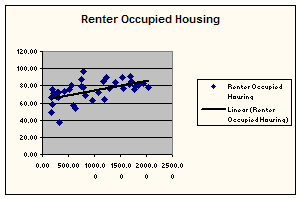
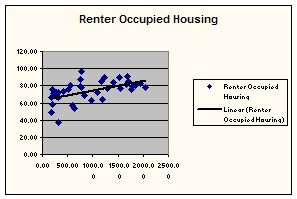
Most of my expectations were confirmed and I learned of a few less mentioned factors instead of the most common IDU that affected the HIV/AIDS rates in Brooklyn such as MSM in wealthier areas. Also, although all of the correlations differed in terms of significance, most of them led me to conclude that the rate of HIV infection is the highest it has been since the epidemic began over two decades ago. This trend has been taking an immense toll on Brooklyn’s population, and unless something is done to minimize its impact on the community, many more will be subjected to it.